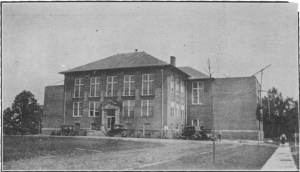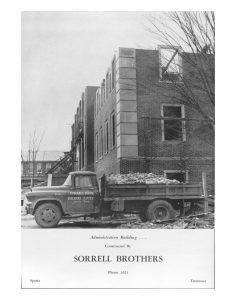by Jacob Johnson (updated 2021-06 by Megan Atkinson)
Derryberry Hall, simply called the Administration Building up until 1962, is the oldest building on campus… more or less.
When Jere Whitson donated land for the form ation of the private school, Dixie College, which was the predecessor to Tennessee Polytechnic Institute (TPI) and Tennessee Tech, the Administration Building was the first structure on the land. Dixie College completed the building in 1912 and the State Legislature purchased it along with about 25 acres of land in 1915, making it a state school, TPI. Two residence halls, East Hall and West Hall, were quickly built following the purchase bringing the campus with three buildings.
ation of the private school, Dixie College, which was the predecessor to Tennessee Polytechnic Institute (TPI) and Tennessee Tech, the Administration Building was the first structure on the land. Dixie College completed the building in 1912 and the State Legislature purchased it along with about 25 acres of land in 1915, making it a state school, TPI. Two residence halls, East Hall and West Hall, were quickly built following the purchase bringing the campus with three buildings.
In its early years, the Administration Building was the center of most activities at the college. It held the offices and classrooms. In 1921, the rather simple building had an east and west wing added and was completely overhauled. After the additions and renovations, the building had three stories, 24 rooms, a library, and an auditorium. That was what TPI’s campus consisted of, with the exception of Tech Farm. As time went on and the campus grew, the Administration Building continued to be the main part of campus. It housed all the administrative offices, the Business Department, and the Home Economics Department.
In 1960, TPI mostly tore the Administrative Building down so that it could be rebuilt better than before. In a statement by Everett Derryberry in 1987 to Christine Spivey Jones in regards to the Administration Building, Derryberry told, “There is nothing from the ground level up of the original building in Derryberry Hall. For all practical purposes and intents, it is a new building. When the architects finished, the foundation walls were used in the new building, but they were extended until it was more than double in size.”
The new building was doubled in size, fireproofed  (it is a surprise it was not before with the smokers on campus), and modernized. In 1962, the State Board named the new building after the Derryberrys. At that time, Everett Derryberry served for over 20 years as the University president with his wife, Joan Derryberry, who was a major supporter and developer of the Art and Music Departments at Tech. As of 1965, according to the annual bulletin released by the University, Derryberry Hall housed the “administrative offices, an auditorium, classrooms, and facilities for the Music Department.” Through the years, many offices have circulated through the building including the library, the Home Economics Department, and Business Administration.
(it is a surprise it was not before with the smokers on campus), and modernized. In 1962, the State Board named the new building after the Derryberrys. At that time, Everett Derryberry served for over 20 years as the University president with his wife, Joan Derryberry, who was a major supporter and developer of the Art and Music Departments at Tech. As of 1965, according to the annual bulletin released by the University, Derryberry Hall housed the “administrative offices, an auditorium, classrooms, and facilities for the Music Department.” Through the years, many offices have circulated through the building including the library, the Home Economics Department, and Business Administration.
As you are walking around campus, look up and you will see a landmark perched upon Derryberry Hall, the clock tower. The clock tower features a clock on each of its four sides, a carillon sound system, and the the Golden Eagle. Designed to be aesthetically pleasing, but primarily functional, the tower’s purpose was to house the clock and carillon sound system, keeping time for campus and students. The Golden Eagle was nested atop the Jere Whitson Memorial Library (Jere Whitson Hall) but was moved to Derryberry after the building’s 1960s “renovation”. The original eagle statue came to Tech in 1952, after being lifted from the Monteagle Hotel in a heist by three students. The current eagle atop of the hall is one of two replicas made by the Appalachian Center for Craft. Tech gave the second replica to the town of Monteagle to replace the one lifted in the student heist. The piece is quite beautiful and if you are ever lost, just look for the eagle roosted upon Derryberry Hall or listen for the carillon bell chimes.
RG116, Christine Spivey Jones, “Tennessee Tech buildings articles and programs, 1949-1998,” Box 47, Folder 1.
